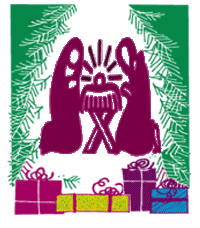

Village Life: December 1996
by Melissa Lauber

"The world needs Christmas," Bishop H. George Anderson of the Evanglical Lutheran Church said recently. Beyond the frenzy, past the consumerism, and amid the false glitter of tinsel-strewn expectations, Christmas still has the power to reclaim an age-old religious truth. God once lived among us, born in a manger as a human child.
This year 5,716,425,000 Christians around the world will celebrate the truth of these "glad tidings of great joy."
For most, Christmas will come alive in the recognition of symbols and
ritual which are the lifeblood of the soul. With symbols, people point to
and understand concepts too deep for words to express. Rituals allow us to
slow down time and create a sacred space in which we can experience God.
In the church's earliest days, there was no Christmas. It wasn't until three
centuries after the birth of Christ that the holiday was recognized. Few
religious scholars today will point to Dec. 25 as the exact birthday of
Jesus. Evidence indicates such a date is unknowable.
But in the first half of the third century Hippolytus, bishop of Rome, proposed Jan 2 as an appropriate date for a celebration of Christ's baptism and natural birth. Others at that time referred to the complicated "Plan of the Ages," which named March 25 as the date of the creation of the world. If Christ was conceived on this day they reasoned his birthdate would be Dec. 25.
This date was already marked by pagan rituals celebrating the winter solstice or "the return of the sun." In the Roman observance, small gifts were exchanged. In Britain and Scandanavia, a huge log or a whole tree, the Yule Log, was cast into a bonfire. Revelers danced and sang around the fire, hoping to awaken the sun from its winter slumber and hasten spring.
In working to convert the unchurched to Christ, Pope Julius I, in the fourth century AD made Christmas, on Dec. 25, an official part of the church calendar. (Although the change to the Gregorian calendar in 1752, pushed the date back 11 days, causing some purists to still observe Jan. 7 as the day of Christ's birth.)
The adoption of pagan rituals for "Cristes maesse" or "Christ's mass," became a common practice as Christianity spread throughout the world.
In Rome, people gave each other simple gifts like twigs from sacred groves to celebrate the festivals of Saturnalia and Kalends, which revolved around the passage of winter. The practice of exchanging small gifts became traditional and has become an essential ingredient of Christmas. In many cultures gift giving is also associated with the Magi who brought gifts to the Christ child, or with St. Nicholas, who evolved in many countries into Santa Claus.
Although the church did not sanction many of the festivities which sprung up around the holiday, it did not usually discourage people from their celebrations.
During the Middle Ages in Germany, mystery plays were performed on the feast day of Adam and Eve. These pageants featured a decorated evergreen to represent the Tree of Life from the Garden of Eden. Today's Christmas trees trace back to these celebrations.
In Italy, St. Francis of Assisi gave a Christmas sermon standing in front of a manger scene he had asked a man from the village of Greccio to create.
These creches developed into a popular folk art form, often encompassing whole villages of figurines. In France molds for the "santons," or little saints, have been handed down since the 17th century.
Poinsettias became connected with Christmas in 17th century Mexico. Acording to legend, a boy named Pablo was headed to his village church to visit the Nativity scene when he realized he had no gift for the Christ child. He gathered some green branches by the roadside. Although the other children laughed at his gift, when he laid them before the manger, brilliant red star-shaped flowers appeared on each branch.
Even the candy cane has religious significance. According to tradition, the Christmas confection was created by a candymaker in Indiana who wanted to commemorate Christ.
He chose hard candy to represent the solid rock on which the promises of God are built. The white represented the sinless nature or Christ, while the red stripes symbolized the bloody gashes received by the Messiah before he was crucified. The candy is shaped in the letter "J" for Jesus and also represented the staff of the Good Shepherd.
In different cultures around the world, the Christmas season is celebrated in a variety of ways, each making personal the promise of Christ's birth.
A brief scan of the globe indicates the joys and symbolism of Christmas historic rituals:
This rich mosaic of traditions and rituals, within and outside of church walls, helps Christians make real the message "Unto you is born this day in the city of David a Saviour, which is Christ the Lord."
The world does indeed need Christmas. Joyeux Noel. Feliz Navidad.
Froehliche Weihnachten. Sung Tan Chuk Ha. Een Plesiergiege Kerfees. Merry
Christmas.
Copyright © 1998 Villagelife.org Inc. All Rights Reserved